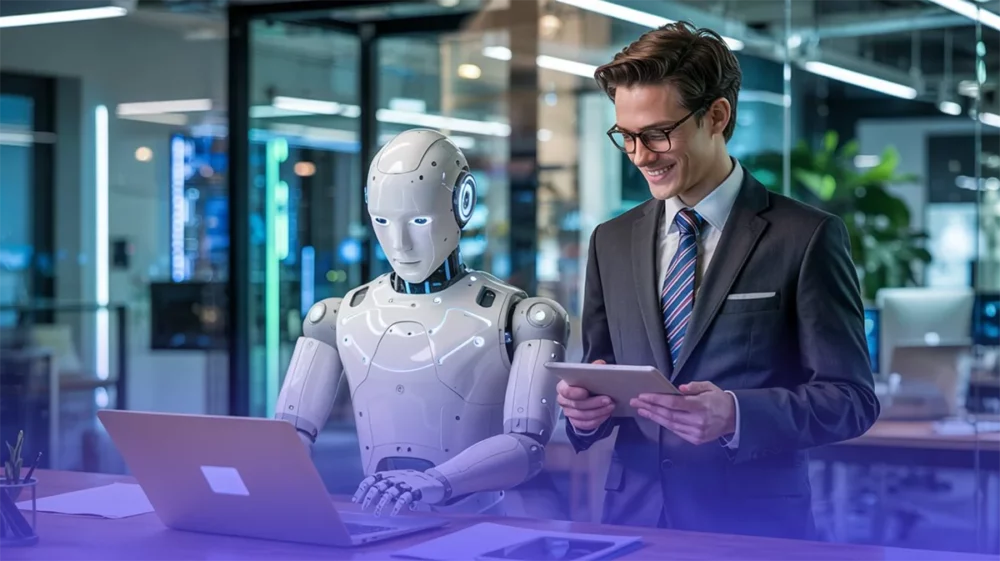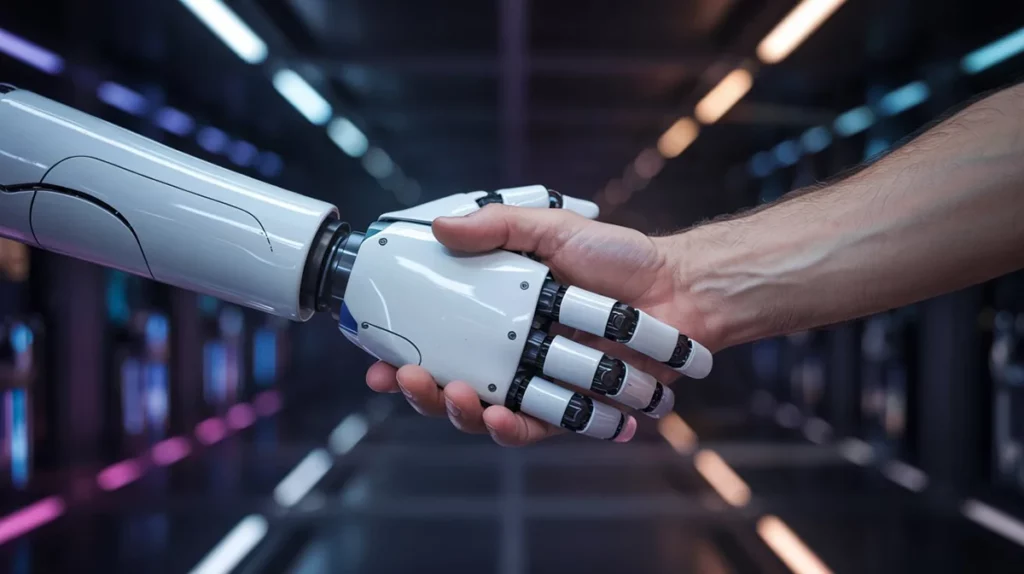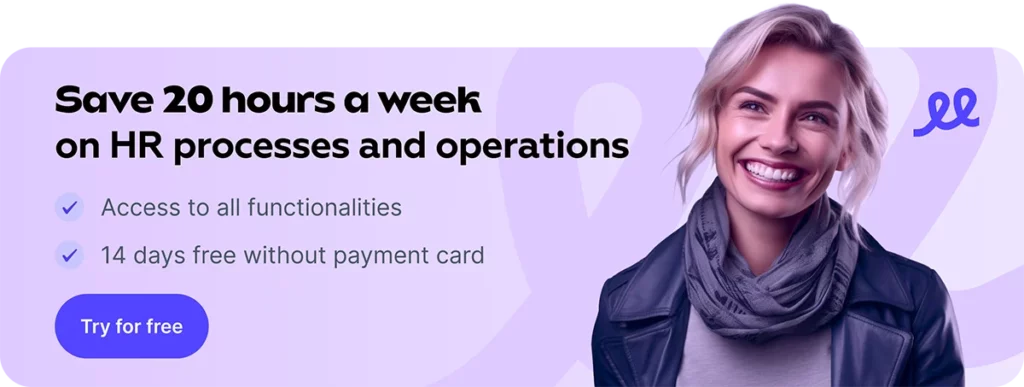HR Agents: Robots in HR? No – colleagues who never forget

Imagine having a colleague on your HR team who never gets tired, never forgets to reply to an email, and learns from every new situation. No, your colleague isn’t Q from James Bond. This is the reality with AI agents. In this article, we’ll take a look at what AI agents are and how they can be useful in HR.
What is an AI Agent?
An AI agent is a digital worker capable of making independent decisions, learning continuously, and acting without waiting for your instruction.
Sometimes it’s built on generative AI (like ChatGPT), but it goes further—with the ability to work with data, integrate into systems, and perform real-world actions.
AI agents, also known as autonomous or intelligent agents, are systems designed to perform specific tasks without the need for human intervention, leveraging their advanced capabilities to adapt and function in dynamic environments. These agents are built to tackle complex tasks by utilizing a model that incorporates continuous learning, allowing them to improve over time and handle increasingly sophisticated challenges.
By automating routine processes and enhancing decision-making, AI agents can significantly boost organizational efficiency and productivity, freeing human workers to focus on more strategic, mission-critical initiatives. Their capacity to operate independently and integrate seamlessly with enterprise systems through pre-built connectors and custom APIs makes them a powerful tool for businesses aiming to streamline operations and reduce costs associated with inefficiencies and manual processes.
Types of AI Agents
AI agents can be categorized based on their complexity and the tasks they perform. The primary types of AI agents include simple reflex agents, goal-based agents, utility-based agents, and virtual assistants.
Simple reflex agents operate on a condition-action rule, responding to specific stimuli without considering the broader context. These agents are efficient for straightforward tasks but lack adaptability.
Goal-based agents, on the other hand, are designed to achieve specific objectives and can evaluate various actions to determine the best path forward, providing more flexibility in dynamic environments.
Utility-based agents add another layer of sophistication by considering multiple factors to optimize performance and make decisions that maximize an agent’s overall utility. They excel in complex scenarios where trade-offs are necessary.
Lastly, virtual assistants represent a versatile type of AI agent, capable of performing a wide range of tasks from scheduling to customer interaction, often leveraging natural language processing to enhance user engagement.
Each type of AI agent has a unique agent function tailored to different business needs, allowing organizations to choose the most suitable agents for their specific operations.
The Difference: Generative AI vs. Copilot vs. AI Agent
At first glance, it might all just seem like “AI” and that’s it. But here’s a simple breakdown:
- Generative AI is like a creative brain without hands. It can write emails, generate job ads, or suggest onboarding guides. But it can’t take action or integrate anything into your systems by itself.
Example: You write a prompt: “Write an email to a candidate letting them know they didn’t advance.” You get a nicely written email in response. - Copilot adds an extra step. It still needs you, but it assists more actively. While writing an email, it suggests sentences, fills in results, or pulls data from the HRIS when you’re completing a performance review. However, it won’t do anything without your approval.
- AI Agent is like an independent colleague. It doesn’t wait for instructions. It monitors what’s happening and acts on its own.
When someone joins the company, the agent handles onboarding: sets up access, sends info, assigns a buddy, and schedules intro meetings. You don’t have to lift a finger.
Example: A new team member starts on Monday. At 9:01 AM, the AI agent sends a welcome email, the team greets her on Slack, and tasks are set in the onboarding checklist.
Features
|
Feature |
Generative AI |
Copilot (Assistant) |
AI Agent (Autonomous) |
|---|---|---|---|
|
Creates content |
✅ |
✅ |
✅ |
|
Responds to prompts |
✅ |
✅ |
✅ |
|
Assists the user |
❌ |
✅ |
✅ |
|
Acts independently |
❌ |
❌ |
✅ |
|
Works with company systems |
❌ |
🔶 (sometimes) |
✅ |
How an AI Agent Works
An AI agent figures out what’s going on, evaluates the situation, and decides what to do. To do this, it relies on three key pillars:
- Workflow Engine – the workflow engine serves as the central command hub of an AI agent, orchestrating complex workflows with precision and efficiency. It seamlessly integrates with real-time data and external tools to automate multifaceted HR processes. For instance, during the onboarding process, the engine not only generates emails but also collaborates with agent platforms to ensure smooth transitions across departments. It assigns new employees to teams, coordinates with IT for equipment setups, and schedules training sessions. These automated sequences exemplify the capability of the engine to manage intricate, interconnected tasks without manual intervention.
Moreover, the workflow engine thrives in multi-agent frameworks, where multiple AI agents work in tandem to cover vast HR landscapes. Supported by no-code platforms, HR professionals can rapidly develop and deploy custom workflows through intuitive agent builders, reducing the need for technical expertise. These platforms offer human oversight capabilities, allowing HR teams to monitor and adjust processes dynamically. Consequently, AI agents powered by such robust engines deliver scalable and adaptable solutions, ensuring every aspect of HR management is efficient and responsive to change.
- Language Models – the AI agent understands queries like “How do I request vacation?” or “Can I work from home?” It also grasps the nuances in statements like “I need a new work laptop.” Based on this, it determines what action to take.
- Integrations – the AI agent connects to the systems your company already uses: HRIS (such as Sloneek), Slack, Gmail, MS Teams, or your calendar. When an employee sends a question via Slack, the agent not only responds, but also sets the vacation in the HRIS and updates their availability in the calendar.
HRIS: Where the Agent Gets Its Data
Data is essential. AI agents work best when they’re connected to HRIS systems that manage attendance, documents, contracts, skills, timelines, and vacation planning. That’s where the AI sees what’s happening and who needs help.
To make everything work, human input is still necessary. Data is usually entered into the HRIS by someone in HR, a team lead, or the employees themselves. For example:
- The HR manager creates a new employment contract and saves it in the HRIS.
- An employee submits a vacation request through the self-service portal.
- A team lead updates goals or skills in their team members’ profiles.
What about the knowledge base the AI agent uses to answer questions? It’s usually built by the HR team over time—by transferring information from internal policies, FAQs, or onboarding notes. In Sloneek, internal documents and guides can be easily created and used by the agent to provide answers.
The better and more up-to-date the data you enter into the HRIS, the smarter and more accurate your AI agent becomes.
Real-time data and machine learning play a pivotal role in enhancing HR agents and supporting human users during the digital transformation of HR operations. By leveraging real-time data, HR agents can provide immediate and accurate responses to employee inquiries, ensuring swift and efficient support. Machine learning algorithms continuously analyze this data, allowing the system to learn from past interactions and improve its predictive capabilities. This enables HR agents to anticipate the needs of human users, offer personalized solutions, and adapt to evolving HR policies and practices. As a result, organizations can achieve a seamless digital transformation, optimizing HR workflows and enhancing employee satisfaction and engagement.
Practical Uses of AI Agents in HR
Recruitment
Imagine you just glance at the system, and the agent is already reviewing CVs, selecting top talents, and inviting them to the first interview round.
Onboarding
A new colleague is starting, and your hands are free. Why? Because the agent has already set up their access, introduced them to the team, sent a welcome email, and scheduled introductory meetings.
Employee Support
How much vacation do I have left? How do I request a home office? Where can I find my employment contract?
The AI agent answers 24/7, whether the question comes through Slack, email, or a mobile app. A lookup agent finds numbers; a knowledge agent explains processes.
Performance & Development
The agent monitors who’s doing well, who’s struggling, and where bottlenecks are. Then it makes suggestions like: “Hey, this course could be just right for Tereza, who’s tackling team leadership.”
Feedback & Well-Being
How are people doing? How do they feel in their team? What’s bothering them?
The AI agent sends micro-surveys, analyzes responses, and raises flags when something needs attention.
AI Agents as Personal Assistants
AI agents have become invaluable personal assistants, especially in handling repetitive and simple tasks that often consume a significant portion of an employee’s time. These intelligent systems streamline workflows, automate routine activities, and enhance employee experiences by allowing both employees and human agents to focus on strategic and impactful work.
For example, the Employee Self-Service Agent at Microsoft provides quick and accurate answers, reducing support tickets and disruptions. Through continuous user feedback, AI agents refine their agent capabilities, tailor responses, and improve AI-powered experiences over time—ensuring efficient, personalized assistance across the organization.
Agent Development and the Future of HR
The landscape of human resources is undergoing a significant transformation with the advent of agent development and agentic AI. Today’s innovations in AI technology are reshaping how HR teams operate, offering new opportunities to enhance efficiency and improve employee satisfaction.
One of the most exciting trends is the development of custom agents tailored to specific HR needs. Using build-your-own agent-building frameworks, organizations can create personalized AI solutions that address their unique challenges. These frameworks often incorporate prompt chaining and LLM agents (Large Language Models) to ensure that the AI can understand and respond to complex queries, making HR processes more seamless and intuitive.
Agentic AI represents a paradigm shift in how AI is applied within HR. Unlike traditional assistive AI tools that wait for prompts, agentic AI can autonomously identify issues and opportunities, responding in real time. This proactive approach allows HR departments to manage workflows more effectively, from talent acquisition to employee onboarding and beyond.
Several leading tech companies and startups are at the forefront of this AI revolution. Google Agentspace and Agent Garden offer platforms for developing multi-agent AI systems, while ServiceNow AI Agents and Agent Assist provide enterprise-level solutions that integrate with existing HR ecosystems. Open-source models are also becoming increasingly popular, enabling businesses of all sizes to access cutting-edge AI technologies without the prohibitive costs.
AI agent startups are at the forefront of innovation, developing HR agent AI, open AI agents, and Google Chrome-based tools that streamline operations, enhance talent management, and boost employee engagement. These versatile solutions can be tailored to the specific needs of HR teams, utilizing the robustness of Google Cloud to ensure scalability and reliability in handling HR functions.
As the best AI agents continue to evolve, they hold the promise of revolutionizing HR practices by automating routine tasks and providing valuable insights through data analysis. This shift will allow HR professionals to focus on strategic initiatives that drive growth and foster a positive workplace culture.
In summary, agent development in HR is not just about automating processes; it’s about creating intelligent systems that enhance the human experience at work. With the rapid advancements in AI technology, the future of HR is poised for a transformation that will redefine how organizations attract, retain, and engage talent.
Sloneek + AI = A Powerful HR Combo
Sloneek is one of those smart HR systems that isn’t just a passive database but the active brain of your HR operations.
Want to get the most out of AI assistants? Check out our Library of Best AI Prompts for HR Teams. You’ll find step-by-step guides, templates, and automation tips. More inspiration and useful information are also available in our knowledge base.
AI agents aren’t science fiction. They’re valuable teammates who make HR smarter and faster, freeing up HR professionals to focus on people and HR strategy—becoming the strategic partner the management team needs.





